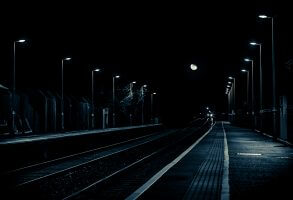Support Hidden Compass
We stand for journalism, science, history, and hope. Make a contribution to Hidden Compass and stand with us.
Once upon a time, I walked on stars.
Distant suns shimmered above my head and beneath my feet as I stepped into a black inland sea only a few inches deep. I’d been waiting for a night like this. Crisp and clear. Still as a shadow. Dark as ink — save for the lights of the universe.
I walked out into the night, towards the Magellanic Clouds floating in the sky alongside a spray of stars — the core of the Milky Way. I floated alongside thousands of points of light. I breathed in the vastness.
If I could have stayed in that moment, I would have.
But with the first rays of light stretching across the horizon, the sun tugged me back to Earth. I clung to the night as the stars began to disappear.
And then, like the misty tendrils of a dream, the universe faded to morning, and reverence returned to longing. I knew the cycle well. I’d been raised to chase that particular high.
~~
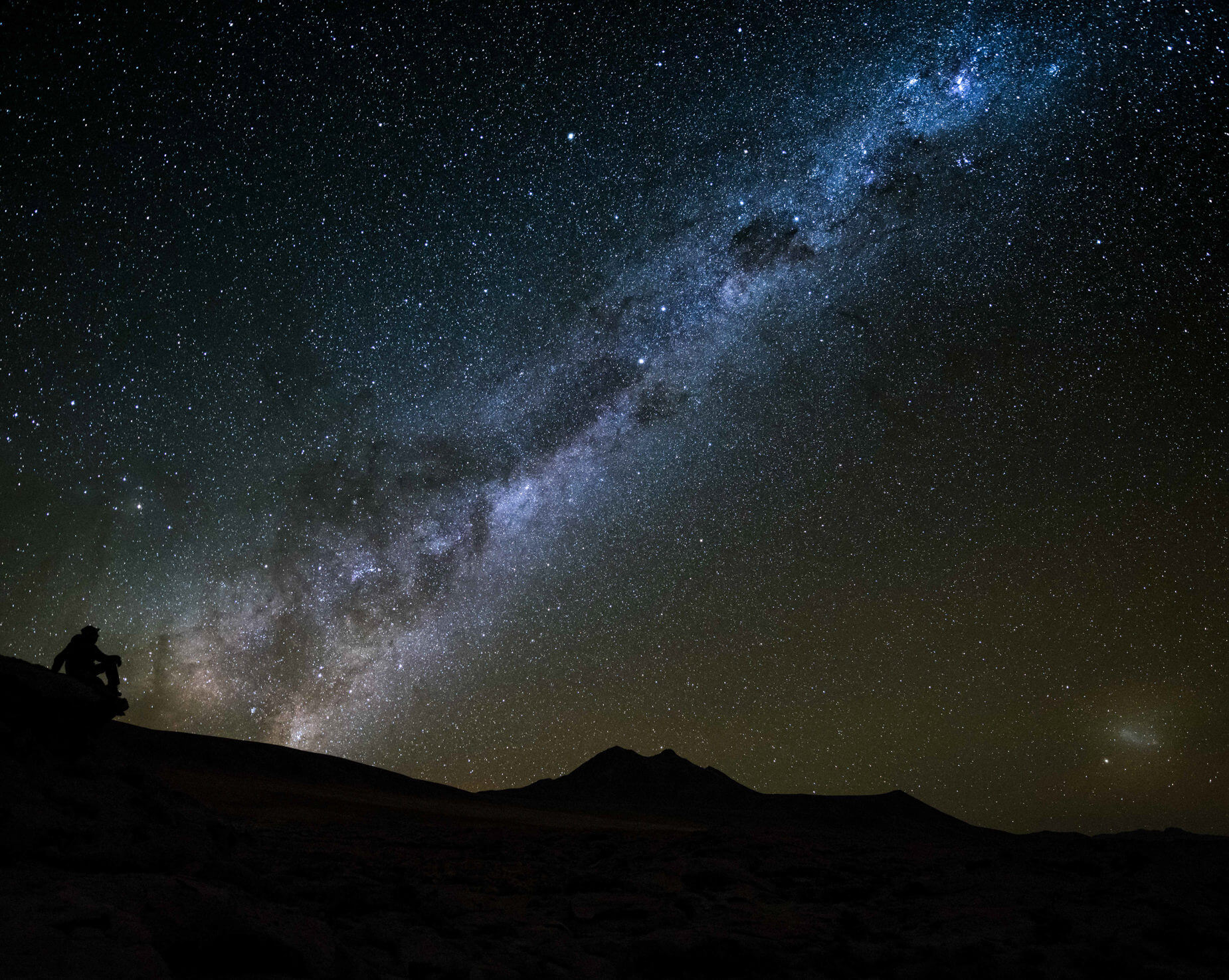
As a child, author Sivani Babu spent nights staring up at the sky. As an adult, not much as changed. Here, a friend sits on a rocky outcrop in the Atacama Desert, while the Milky Way glows in the sky. Photo: Sivani Babu.
Astronomy was a staple of my upbringing. Countless nights, I’d stood in my childhood driveway with my parents, bouncing in my untied high-tops to ward off the chill, as we all cast our eyes to the firmament. I listened, captivated, as my dad explained the Big Bang and the Doppler Effect, sketching visual aids for the latter on a napkin or piece of scrap paper. I looked at the smoldering sky and dreamt of visiting another planet, another solar system, another galaxy. I learned to identify stars and constellations — Betelgeuse and Arcturus, Ursa Major and Ursa Minor, Cygnus and Cassiopeia. But it was Orion, the hunter, that I always greeted with a cheerful hello.
We’d stand in that small-town driveway, our heads tilted back until our necks hurt and my dad inevitably quoted Francis William Bourdillon.
“‘The night has a thousand eyes, And the day but one…’” he would say, as our breath condensed in puffs of steam.
Children often fear the dark of night, but through meteor showers and moonsets, I learned there was poetry written in the night sky.
~~
“It often seems to me that the night is even more richly colored than the day, colored in the most intense violets, blues, and greens.”
– Vincent van Gogh, Letter to Willemein van Gogh, September 9, 1888.

Home to some of the darkest skies in the lower 48 states, the remote Big Bend Region of Texas is perfect for chasing starlight. Big Bend Ranch State Park, Texas. Photo: Sivani Babu.
When he painted his first starry sky, behind the gas-lamp-lit Café Terrace in Arles, France, Vincent van Gogh did so in situ, in the dark. That was, he believed, the only way to accurately capture the colors.
As a painter, van Gogh is often remembered for his bold and frenzied brushwork. But nighttime brought out a different side of him — a more thoughtful and restrained side, according to art historian Joachim Pissarro, a former curator of New York’s Museum of Modern Art and the great-grandson of French Impressionist Camille Pissarro.
“Contrary to an enduring misconception of van Gogh as a rough and ready chromomaniac… the artist’s twilight and night scenes are actually elaborate constructions that also call on his vast literary knowledge,” Pissarro, who curated an exhibit titled “Van Gogh and the Colors of the Night” back in 2009, told a reporter.
Elaborate constructions seems like an understatement. Van Gogh’s fidelity to the stars and their position in the sky was precise enough to be able to date the night of that first starry painting to September 16 or 17, 1888. Van Gogh was also an avid reader of poetry. Seldom would he write a letter to his brother or sister that didn’t include lines from poems, or even entire poems copied to share with them. He sent Henry Wadsworth Longfellow’s “The Light of Stars” to his brother, Theo, twice — in hopes that Theo would enjoy it as much as he did. And right as he was painting his first starry sky, Vincent wrote to his sister of the inspiration he was finding in Walt Whitman’s star-laden imagery.
“Now there’s a painting of night without black,” van Gogh wrote to his sister immediately after completing “Café Terrace at Night,” as the painting would come to be called. “With nothing but beautiful blue, violet and green.”
But the “Café Terrace at Night” was just the beginning. Until his death, van Gogh would chase the stars through many paintings, a pursuit that would lead him to his magnum opus.
~~
I gulped in air as I hiked up the dusty trail, stepping over snags of roots and around protrusions of stone. At sea level, it would have been a relatively easy jaunt into the forest, but the sudden arrival at more than 10,000 feet of elevation left my lungs aching.
For millennia, certain members of Pinus longaeva — the bristlecone pine tree — have stood beneath the stars in California’s White Mountains. The longest-lived individuals on the planet, some of these trees have survived for nearly 5,000 years.
As the soft light of a lantern lit the path at my feet, I spotted a gnarled bristlecone up ahead. I turned off the lantern and approached slowly in the dark, my eyes adjusting. I took in its stout trunk, which I estimated to be several feet wide, and I tilted my head back to fully see it tower over me.
“The things you’ve seen,” I whispered to the sinewy branches. As I stared up above the tree, I caught a glimpse of the blue-white supergiant Deneb — a star in both Cygnus and the Summer Triangle. At more than 15.3 quadrillion (that’s 15 with 15 zeros after it) miles from Earth, the light from Deneb had been traveling through the universe for roughly 1,500 years before it reached us.
I turned back to the tree. I bet you were alive when it left Deneb, I thought.
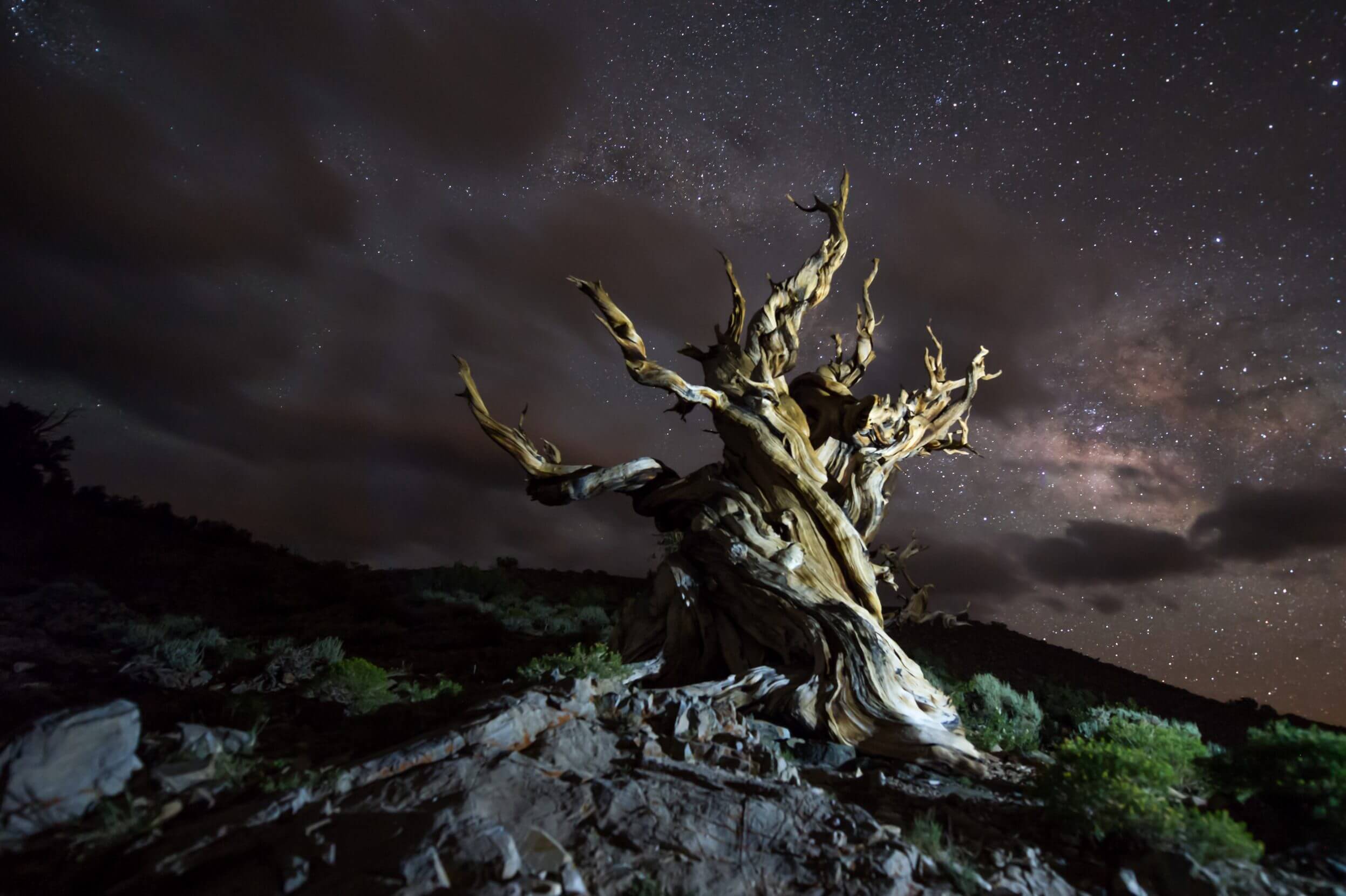
The Ancient Bristlecone Pine Forest in California’s White Mountains is home to the oldest living individuals on the planet. Some of these slow-growing trees have been around for almost 5,000 years. Photo: Sivani Babu.
Overhead, patchy gray clouds threatened rain, but the glimmering stars whose light pierced through shone in shades of rose and violet and what Vincent van Gogh had called “forget-me-not blue.”
There’s much about van Gogh I’ll never understand. The snapshots of his life are as fleeting as starlight, as patchy as the clouds above. But there’s one impulse of his I recognize.
~~
“And it does me good to do what’s difficult. That doesn’t stop me having a tremendous need for, shall I say the word — for religion — so I go outside at night to paint the stars…”
–Vincent van Gogh, Letter to Theo van Gogh, September 21, 1888
I’ve chased dark skies for years.
In the Chilean Atacama, the skies were so dark, the dense core of the arcing Milky Way sent a shaft of light down to earth like a spotlight.

In the high desert of the Chilean Atacama, the Milky Way arcs across the sky. Considered to have some of the darkest skies on the planet, the Atacama Desert is home to high-powered research telescopes and NASA training missions. Photo: Sivani Babu.
In the Siberian tundra, above a reindeer skin-covered chum, the darkness of night gave way to a pulsing current of green.
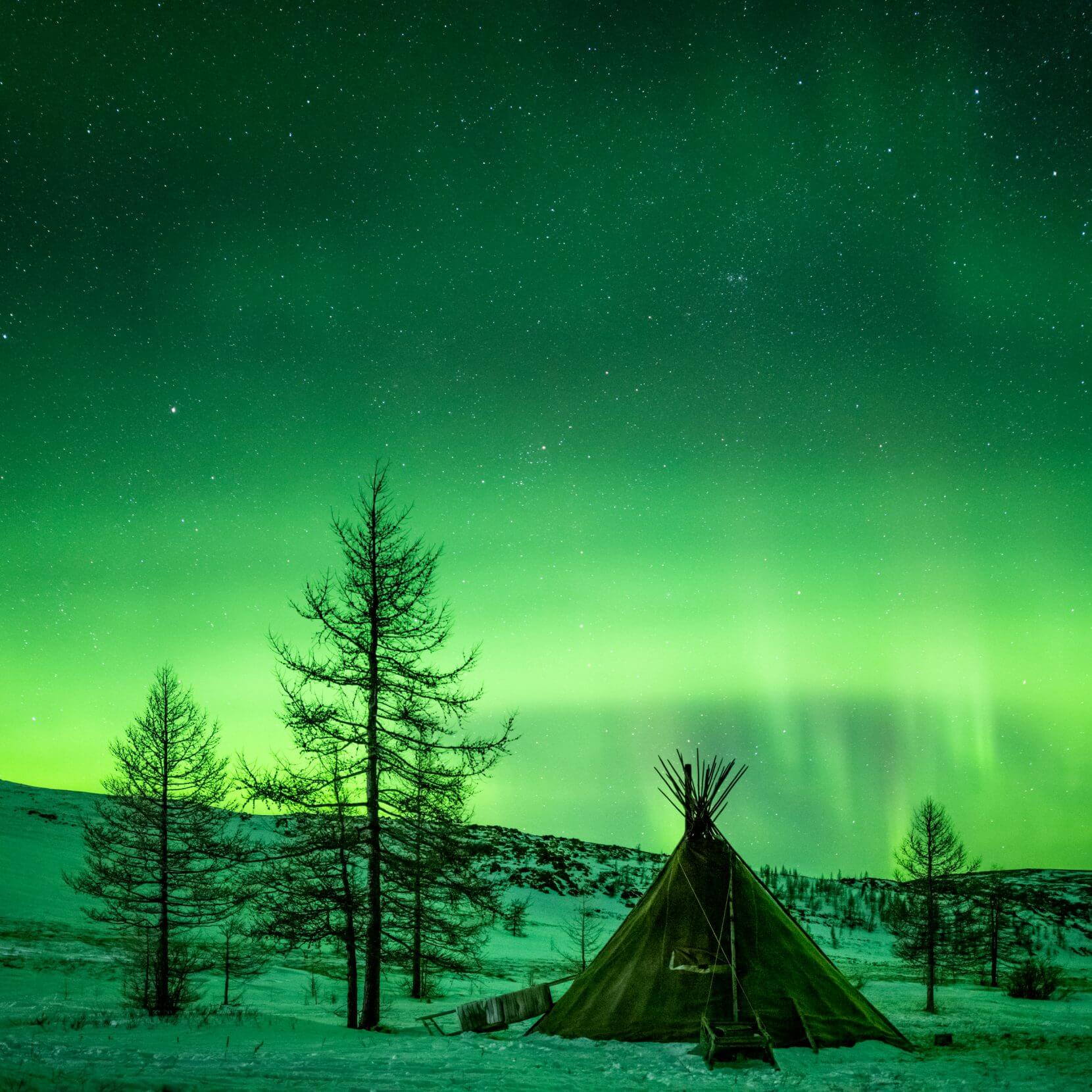
Above the Arctic Circle, the Aurora Borealis fills the sky over traditional Nenets chum. The Nenets are nomadic reindeer herders who are indigenous to the Russian Far North. Photo: Sivani Babu.
Oregon, Texas, and California. Kenya, New Zealand and Patagonia. The farther I went, the farther I had to go.
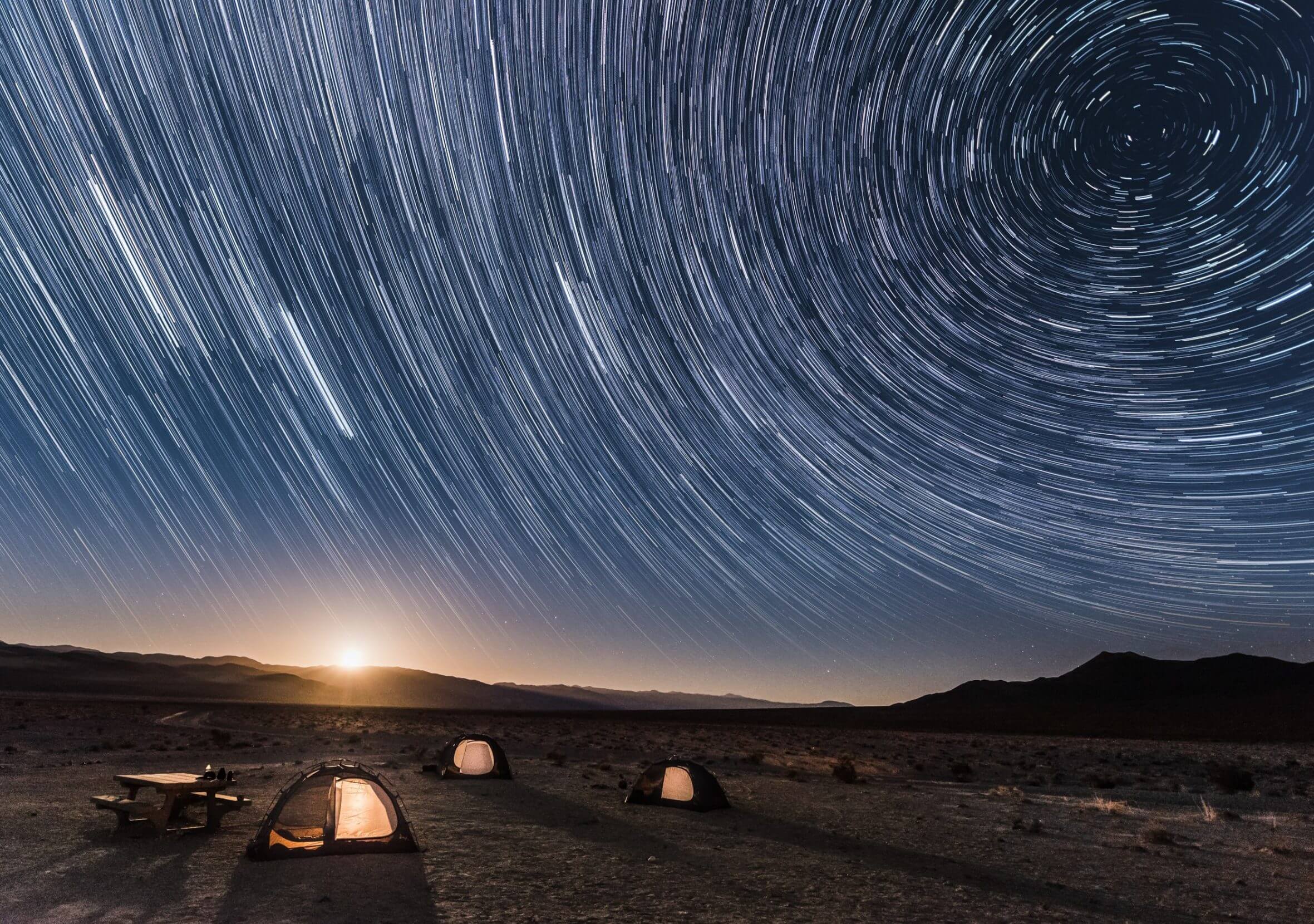
Star trails and a moonset over the Eureka Dunes campground at Death Valley National Park. This image is composed of more than 170 different photographs taken over several hours. Photo: Sivani Babu.
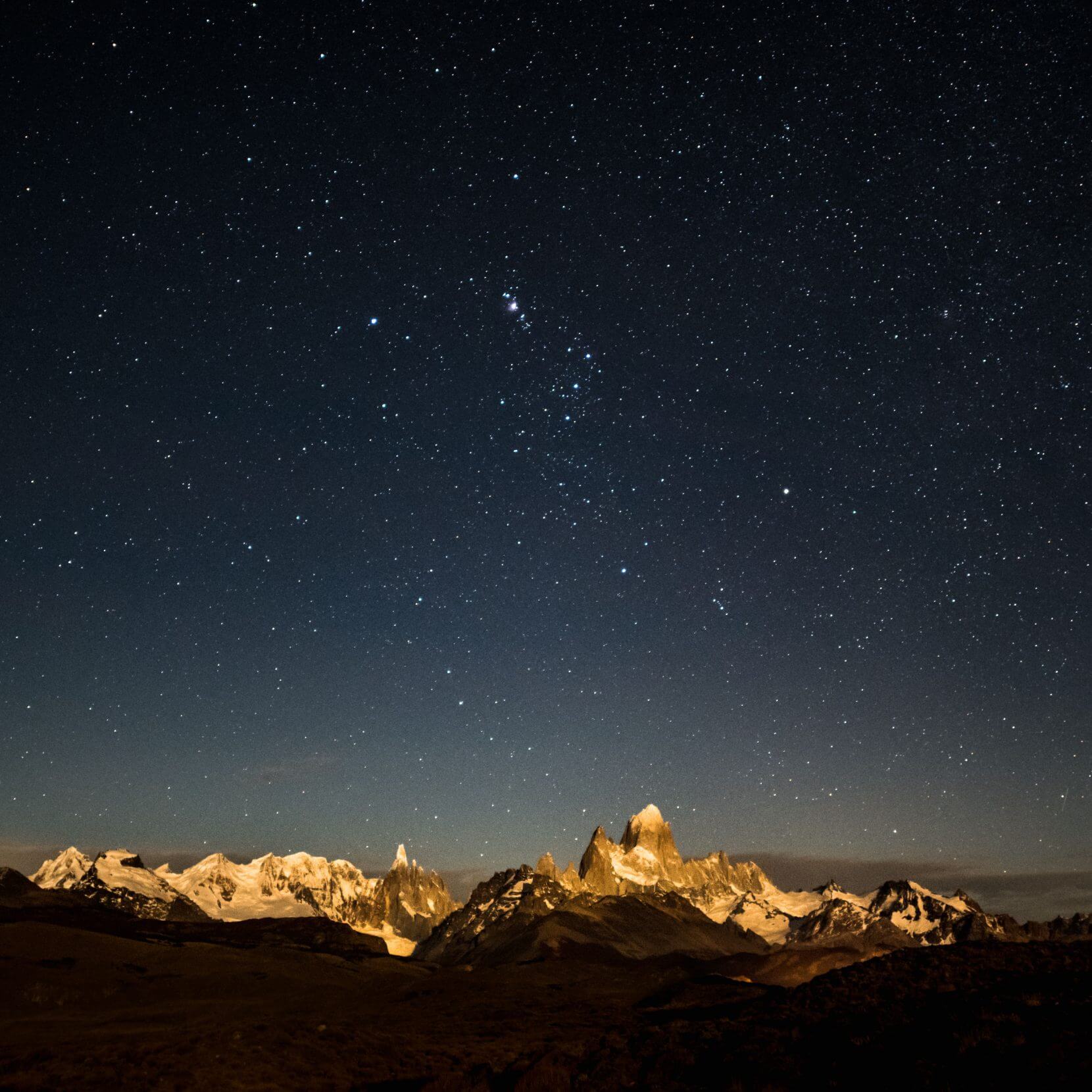
As the moon rises, its light strikes Chaltén (Mt. Fitz Roy) and Cerro Torre in Patagonia. Photo: Sivani Babu.
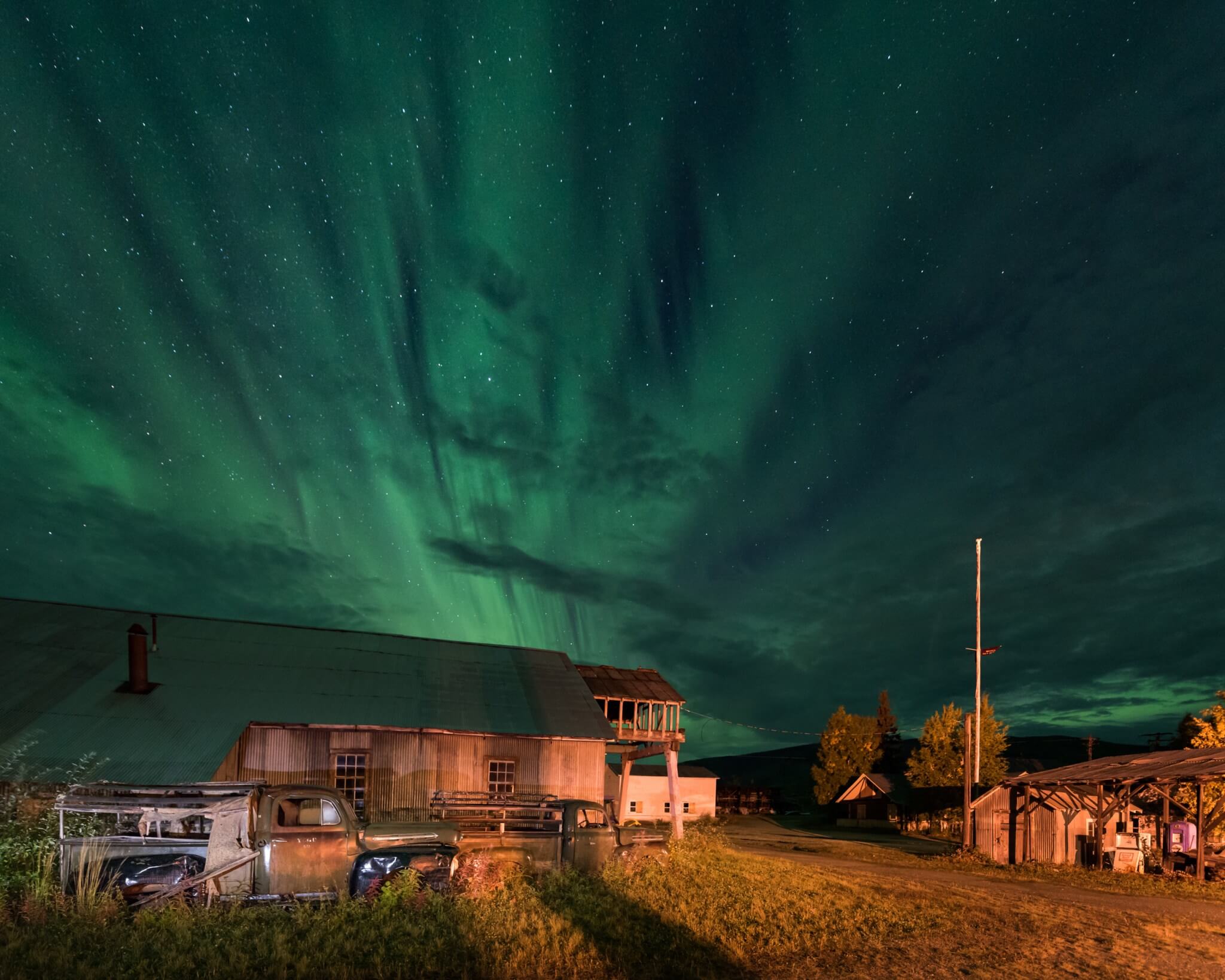
In the Canadian Yukon Territory, the Northern Lights erupt over an abandoned mining town. Photo: Sivani Babu.
In a world that seemed larger every day, I yearned for a deeper connection to the stars — something akin to van Gogh’s religion.
So, I went as far as I could: To the middle of the ocean.
~~
Lightning arced across the overcast sky as black water beat against our sailboat and a heavy wind tried to bend us to its will. I searched for a break in the clouds, a patch of moonlight — but nothing was visible through the driving rain.
Just a few days into what was supposed to be a six-week sail across the Atlantic Ocean, we had lost the stars. I ached for the sparkling skies that, paired with our sextants (and the sun during daylight hours), had guided our 60-foot sailboat hundreds of nautical miles toward Bermuda. There was no GPS on this trip, and when the stars were out at night, they helped us steer a truer and smoother course than compass alone. Perhaps this was the deeper connection to the stars I’d been searching for — one shared with civilizations and generations of the past.
But now, things were different.
The steering wheel went slack in my hands and I braced myself for what I knew would follow even as my feet lifted off the deck. The hard tug to port wasn’t a surprise, but I had to fight to keep the wheel from spinning. Helming had become a full-body affair — one we took in 20-minute shifts that left our hands cramped and our muscles throbbing.
I glanced down at the compass and noticed the needle drifting west. Turning the wheel slightly, I tried to keep us heading north east, but the compass continued westward. I looked again to the sky, searching for a point of reference, but there was nothing. Then, the compass needle swung swiftly back in the other direction. I held the wheel as steady as I could, waiting for the needle to settle, but it kept turning — past our intended course — until the sail began luffing.
Without a point of reference in the night sky, steering had lost perspective. It was just a cycle of corrections and overcorrections. And there was nothing we could do about it, because as much as I liked to think about chasing the stars, it had never really been a chase at all.
“C’mon,” I exhaled in frustration as the boat began to stall. I turned the wheel again, adjusting the rudder until the luff subsided and the wind pulled the sails taut, only to begin the cycle again.
And on it went.
Until it didn’t. A few days, a freak accident, a fractured vertebra, and a concussion later, I was back in California earlier than anticipated. Suddenly, the comforting vastness of the open ocean had been replaced by the walls of my own home. For months, I puttered around in relative silence, the hours spent mostly in my own company. The world didn’t feel so large anymore.
I’d been traveling continuously for five years. And then, there was nowhere I could go. Each day, I sat in my living room, neck immobilized by a cervical collar, headaches coming and going, thinking about the plans I’d canceled. And I wondered:
What remains when the world is withdrawn?
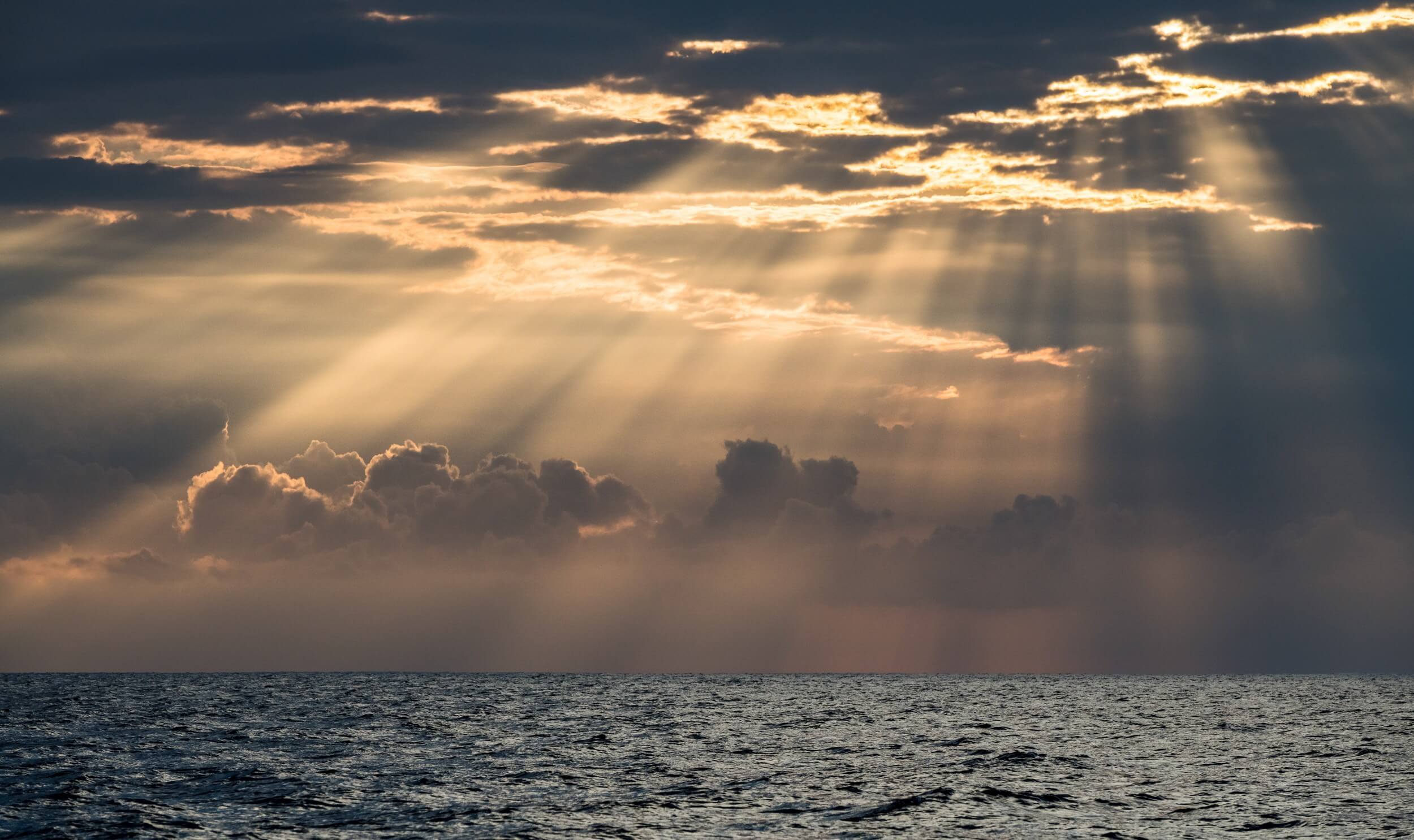
Sunrise in the Bermuda Triangle. Photo: Sivani Babu.
~~
“I take great care of myself by shutting myself away.”
–Vincent van Gogh, Letter to Theo van Gogh, September 5 and 6, 1889
In the autumn of 1888, van Gogh held a razor in his hand and threatened fellow artist Paul Gauguin. They were friends. They even lived together, but conversations between the two men had been heated lately and van Gogh’s agitation had been building, fueled by bouts of paranoia. Still, it was Gauguin’s desire to leave that set van Gogh off that day.
A French post-impressionist, Gauguin was the first, and ultimately only, member of van Gogh’s artist colony in Arles. Gauguin had been reluctant to move in, but Theo van Gogh, Vincent’s younger brother, had cajoled and even bribed Gauguin until he acquiesced. The artists began collaborating, producing remarkable works, including colorful portraits of one another, but Gauguin preferred to work from memory and imagination while van Gogh painted what was in front of him. These fundamentally different approaches led to spirited discussions that increasingly became arguments. Simultaneously, as 1888 drew to a close, underlying mental health issues began to manifest in van Gogh. When Gauguin threatened to leave, van Gogh met the threat with one of his own.
The anxiety and paranoia that had been plaguing van Gogh finally exploded to the surface. Perhaps violence was inevitable that day, but if it was, the victim was not. In the end, van Gogh did not hurt Gauguin. Instead, in an episode he’d never clearly remember, van Gogh turned the razor on himself. He cut off his own ear (or perhaps just part of it), wrapped it in paper, and presented it to a local prostitute.
He was hospitalized in Arles the next morning, and Gauguin returned to Paris.
Van Gogh’s mental health remained unstable, and in May of 1889, he voluntarily checked himself into Saint-Paul de Mausole, a psychiatric hospital near Saint-Rémy de Provence in the South of France.
In the small room with the yellowed walls, van Gogh looked out at a world of which he hadn’t really been a part for some time, and he put brush to canvas.
Though he never visited van Gogh, Theo arranged for two rooms. Both were small with bars on the windows. One became van Gogh’s studio, and in times of good health, he was allowed to paint. He painted the corridors of the hospital with their grand arches. He painted the olive trees and a local wheat field that he could see from his room. Eventually, he was allowed to paint from the garden and even leave the hospital with supervision.
Clearly, it was a time of struggle and confinement. At one point, van Gogh reported that he hadn’t “set foot outside for six weeks.” But it was also a time of abundant creativity. In his year there, he painted some 150 paintings, including one last study of the night sky.
In the small room with the yellowed walls, van Gogh looked out at a world of which he hadn’t really been a part for some time, and he put brush to canvas.
Though he’d never know it, the view from his barred asylum window would be the masterpiece that defined van Gogh for generations. It would also be the culmination of his quest to paint the colors of the night.
~~
A few months ago, before a virus stopped the world, I sat on a hard bench at the Museum of Modern Art in New York and watched people snapping selfies with a certain famous painting. In the corner, a security guard sang quietly, his voice amplified by the acoustics of the room.
I waited for the crowd to ebb before getting as close to the painting as the singing security guard would allow. The fantastical brushstrokes, the “lemony” yellows and “forget-me-not” blues that van Gogh had once written about in letters to his family, were all present and vivid on the canvas.
I stared at “The Starry Night,” studying it, trying to understand. The turbulence of the end of his life was just as vivid as the colors, but so, too, was the beauty he’d found in the night. How, I wondered, had he found such immense beauty when the world had been taken from him?
~~
“The sight of the stars always makes me dream in as simple a way as the black spots on the map representing towns and villages makes me dream.”
–Vincent van Gogh, Letter to Theo van Gogh, July 9 or 10, 1888
It’s a year after I came home from Bermuda, and once again, there’s nowhere I can go. This time, the entire world has withdrawn, for different reasons still.
I step out onto my driveway, my warm breath billowing in the cool night air as a great horned owl hoots in the distance. The world seems so small tonight, even as distances seem greater. I’ve barely left my home in weeks. My little sister who lives on the other side of the planet, my parents who live an hour away, my friends who live down the street, are all the same distance away. Meters or miles, it all feels like Mars.
I walk to the end of the drive. This is as far as I’ll go. My passport sits on my desk. My camera bag collects dust. There is no duffel bag to pack. The stillness makes me anxious. But then, I look up.
I spot Orion low on the horizon, Betelgeuse glowing red. I smile and greet the hunter just like I did as a child. I won’t create my magnum opus during this confinement. But I’ll weather it better than the last time, because I’ve learned something.
~~
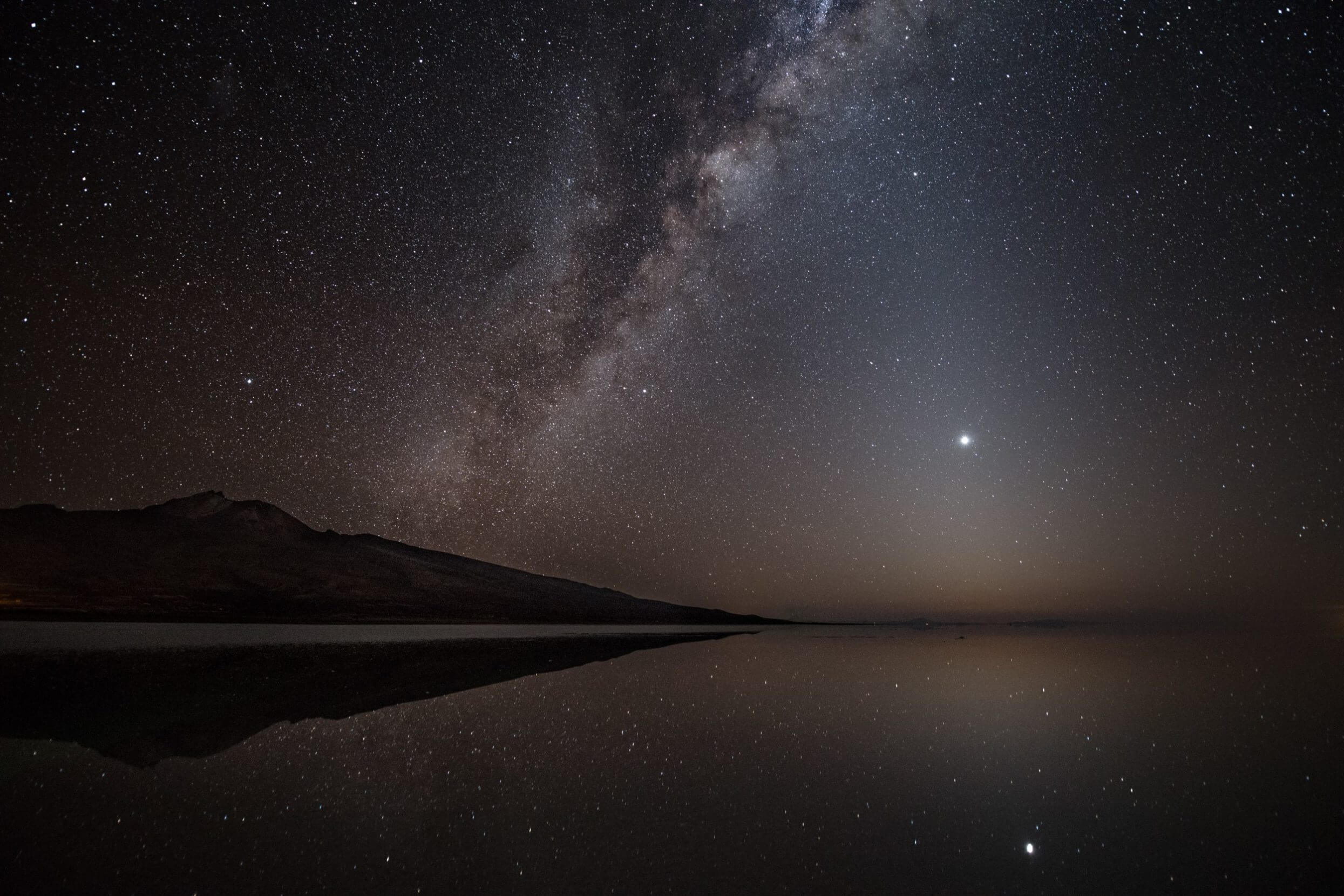
Starlight reflected in Bolivia’s Salar de Uyuni. Photo: Sivani Babu.
Once upon a time, I walked on stars. Behind me, the Aymara God of Thunder — Volcán Tunupa — rose more than 17,000 feet into the sky. Before me, the heavens reflected in a mirror of rainwater covering the Salar de Uyuni, the largest salt flats on Earth.
The starlight I floated in there is the same starlight that sparkled through the bars of a troubled painter’s asylum window in the 19th century. It’s the same starlight that shines on us now.
It doesn’t get closer because we chase it, nor does it disappear because we are still. If anything, the stillness helps us see it more clearly. The world can withdraw, I’ve learned. For when it is stripped away, the universe remains.

Author Sivani Babu “walking on stars” at Bolivia’s Salar de Uyuni. Just above the horizon, a Magellanic Cloud hovers mirrored by its reflection in the water. Photo courtesy of Sivani Babu.
Sivani Babu
Sivani Babu is the co-founder, co-CEO, and creative director of Hidden Compass. By merging journalism, art, and exploration, she tells stories that offer perspective, context, and an awe-inspiring sense of scale to the human experience.
Never miss a story
Subscribe for new issue alerts.
By submitting this form, you consent to receive updates from Hidden Compass regarding new issues and other ongoing promotions such as workshop opportunities. Please refer to our Privacy Policy for more information.


